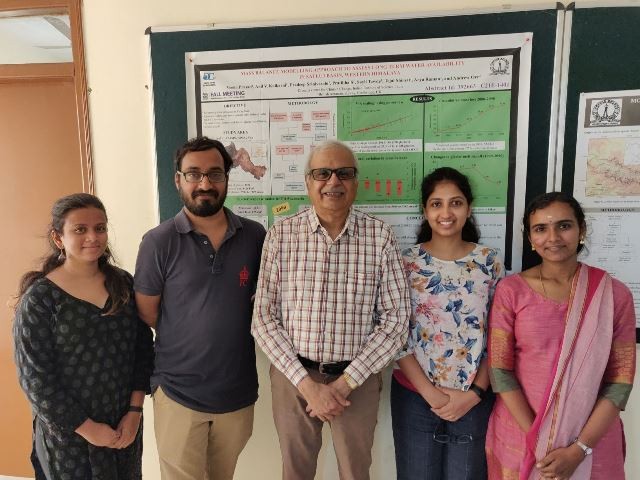Half of glaciers in Satluj basin may disappear by 2050: study
A recent study has cautioned that about 55 percent of glaciers in the Satluj basin is likely to disappear by 2050.

Changing climatic patterns are affecting the health of glaciers in the Himalayan region. A new study has warned that as many as 55 percent of glaciers in the Satluj basin may disappear by 2050 and 97 percent by 2090 under extreme climate change scenario. This could adversely hit availability of water for irrigation and power projects including the Bhakra dam.
The Satluj basin has total of 2026 glaciers of different sizes totaling 1426 sq. kilometers area. Smaller glaciers will melt faster. Those having area of less than one square kilometer will experience about 62 percent of loss by 2050, according to new findings.
Satluj is among dozens of basins in the Himalayan region that have thousands of glaciers many of which are receding while some are not. Almost half of the annual flow of the Satluj river comes from snow and ice melt and it feeds up to 80 percent of the inflow into the Bhakra dam in Himachal Pradesh.
Researchers used different techniques to estimate water locked in glaciers in this basin and then applied climate projection models to see how glaciers will behave as temperature rises.
The study has been done by scientists from the Divecha Centre for Climate Change at the Indian Institute of Science, Bangalore, and results will be published this week in journal Current Science.
For estimating the volume of stored water in Satluj glaciers, researchers used ‘velocity-slope’ and ‘volume-area’ scaling methods. A key parameter called ‘equilibrium line altitude’ (ELA) that shows snow melt and accumulation was calculated using temperature and rainfall data from met stations at Kaza and Rakcham in the basin as well as other sources. Data from Landsat satellite was used to figure out transient snow lines and precipitation gradients.
The analysis showed that the total glacier stored water for glaciers in the Satluj basin was 69 cubic kilometers. About 56 percent of the total volume is stored in large glaciers (over 5 square kilometers) covering an area of 517 square km. The largest glacier spread over 66.8 sq. km and containing 6.5 gigaton of ice is located in Tibet. Most of the glaciers contain less than 0.1 gigaton of ice. The basin has already lost 21 percent or 16.4 gitaton of glacier volume between 1984 and 2013.
Also Read : Water Crisis in Himalayan Ecosystems: The Way Forward
Water reserves held by glaciers are likely to be affected in future due to climate change. The rise in near surface air temperature in North Western Himalayas – 0.65 degree during 1991–2015 – is already higher than the mean global rise of 0.47 degree.
Tejal Shirsat, S. Pradeep, Anil V. Kulkarni, S. Pratibha and A. R. Arya (L to R)
The future rise in temperature has been projected under different scenarios, depending on how much emissions occur in the present century. Researchers used an extreme case model, GFDL-CM3, to assess the impact of climate change Satluj glaciers by 2090. They found that there would be 33% (475 sq. km) and 81% (1157 sq. km) glacier area reduction by 2050 and 2090 respectively.
As per this model, around 55 percent of the glaciers in Satluj basin are likely to disappear by 2050, and by 2090 only 3 percent of the total glaciers will remain.
“Glaciers in the Satluj basin are likely to lose 81% of their area if the temperature rises by 7.9 degrees by 2090. In terms of numbers, 97 percent of the total number of glaciers will disappear. The biggest loss is projected for glaciers measuring less than one square km in area. This is because of shorter response time of small glaciers, making them more vulnerable to climate change,” explained Dr Anil V Kulkarni, who led the research team, while speaking to India Science Wire.
The progressive melting of glaciers will lead to decline of stream run off. The loss in glacier mass and area will affect the contribution of melt runoff to the Bhakra reservoir. “The disappearance of smaller glaciers located at lower elevation will change the pattern and overall availability of water to the various hydropower projects located in downstream areas of the basin, thereby posing new challenges for smaller communities in the Himalayan region,” researchers have observed. It will also increase possibilities of disasters like glacier lake outburst flood (GLOF).
The study team included Veena Prasad, Anil V. Kulkarni, S. Pradeep, S. Pratibha, Tejal Shirsat, A. R. Arya and Sayli A. Tawde (Indian Institute of Science); Andrew Orr and Daniel Bannister (British Antarctic Survey). (India Science Wire)
